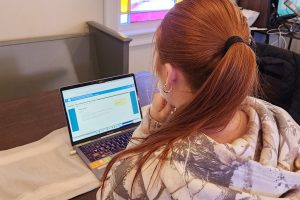
Fostering Excitement in Online Classrooms
- Posted by Lindsey Riebe
- Categories Online Learning
- Date May 3, 2024
DING DONG! The third period bell has just rung, and a few hundred students have now flooded onto a green open space with their lunches. There are thirty glorious minutes until the next bell rings and fourth period begins. The sun is shining, birds are singing, a few frisbees are in the air, a couple soccer balls are on the grass, and groups of students are huddled together, chatting about weekend plans, test scores, and the like.
During my time as a teacher at a brick-and-mortar school, these moments were my absolute favorite, because it gave me thirty minutes to walk outside of my lab classroom and connect with students. Those thirty minutes provided laughter, conversation, and the opportunity for me to share parts of my story and learn about parts of theirs.
Don’t get me wrong—I love having students in my classroom. As a biology teacher, the activity of a humming lab, students making inquiry-based discoveries, and designing experiments is awesome! However, connecting with students on a personal level and building relationships is my favorite part of being an educator. Who would have guessed that setting aside time to connect with students on that grassy knoll for those thirty minutes would lead to some of the best moments of engagement and excitement as a teacher?
Every teacher wants classroom engagement, students who are excited to participate and grow in their understanding of the content being taught. What I learned was that when I took the time to truly connect with students on a personal level, not only did I earn their trust but I saw classroom engagement trend upward as well. Let me be clear: my classroom was not always filled with sunshine and rainbows. I had students fail, I dealt with a handful of disciplinary issues, and yes, the typical teenage drama did not evade my room’s four walls. Yet, the foundation of my classroom was always built upon authentic relationships with each of my students—relationships that allowed me to come alongside students when they were struggling and help them feel seen and heard. When disciplinary action was required, I was often able to sit with a student after class to talk it out. Even if an agreement could not be reached, there was always clear communication on expectations and how we could move forward together. Those conversations happened because of the relationships formed with each of my students.
Most importantly, these relationships laid the foundation for learning. Learning in the classroom takes many paths—but by any measure, it needs a spark. It needs excitement. Let’s be honest: looking at a preserved onion root under a microscope for forty-five minutes may not be most people’s “cup of tea,” but when a biology teacher has a classroom built on relationship, you would be surprised at how many students become inquisitive, eager to explore, and excited to try.
Once trust is established and the student knows you care, you can begin doing what you were called to do: teach. But how does a teacher continue to peak a student’s excitement about learning? Sure, they may love you as a teacher because you care, but how do you encourage them to pursue a love for learning? You guessed it: you continue to foster relationships.
Most students fear an educational subject because they have convinced themselves that they cannot learn it or that it will never be applicable to them. Not true. With a strong personal relationship established, where the student knows you care, you can begin encouraging a love for learning, regardless of content, helping them discover the ways they learn best.
Though it makes me shed a tear, statistically speaking I know that many of my students will never pursue a career choice where biology and chemistry are the foundation. However, I know that every student I work with will need to be able to move forward in the world, positively, and productively, to make it a better place. By establishing a relationship with my students and teaching them how to learn, my hope is that they are picking up skills that will carry them toward whatever God is calling them to.
Now, you might be thinking, “That all sounds great, but I teach in an online setting. How does this apply?” When I decided to transition from a brick-and-mortar teacher to an online instructor, I asked the same question. How do I connect with these students—some of whom are halfway around the world from my home office? How do I bridge the cultural and even religious gaps that may be present? What I realized was that regardless of where my classroom was, it all came down to fostering relationships, even if the only connection available was through my phone or computer screen.
Online education has many pros but there are also a few cons. When I first started teaching online, I saw the relationship piece as a major con for online education. I am no longer able to walk out onto a green open space at lunch and ask, “How’s life?” “I heard about your grandmother; can I pray with you?” or “Hey, did you get the job at the donut shop?” However, after four years of teaching in the online system, I can confidently share that I was wrong. It may be harder to cultivate relationships with online students, but it is not impossible, and it is just as important. What it takes is the same intentionality—a desire to foster relationships—which leads to engagement in the course and hopefully excitement about the content.
Whether it is Zoom, Skype, or Google Meet, creating the dynamic of a green open space is possible. It is a state of mind—being intentional with each call, with each email, during every feedback lesson with a student, allowing students to feel seen by their instructor. What I have found is that it is quite easy to (1) ask questions and be intentional, (2) follow up on previous conversations and make the effort to show you care, and (3) model how to treat people in nontraditional, virtual environments.
I start each email or phone call with a few questions: How are you? What questions do you have? How did that last quiz go? How can I support you? I also make sure to follow up on previous conversations. For example, I had a student share during a phone call that they were practicing the scientific method in their day-to-day life. It was a small, even flippant comment, but I had jotted it down in my notes. The next time we spoke I recalled that piece of information and asked, “How is that scientific method going for you?” The student shared that she had been making observations about a fish living in a local pond near her house. This sparked quite a discussion about the scientific method that was natural, exciting, and educational. By jotting down a quick note and following up later, I was able to demonstrate my care for this student as an individual, grow our relationship, and the icing on the cake was that she was engaged enough to share what she had learned. She was excited about the content!
I also see relationship-building as a way to model to my students how to treat others. By taking the time and putting in the effort to connect with my students, I’m attempting to teach them the importance of connecting not only with me, but with their peers and the content they’re learning. Creating relationships is a soft skill, which translates into many scenarios. The world is moving fast. Technology that was relevant five years ago is out of date today. I don’t consider myself “old,” and yet I remember watching Beta videos and listening to cassettes. So, although our students will face the challenges of an ever-evolving world in both their chosen disciplines and day-to-day life, what will remain constant is how they must engage with each other and what they are called to do.
God calls us to relationship. He wants us to share in the excitement of new friendships, mentorships, partnerships, and the work we do daily. When we walk into that invitation of relationship, we engage with Him and what He is doing in our lives, and in the lives of those around us. So how do we model relationships, engagement, and excitement in our classrooms? By modeling how God desires relationship with all of us. He asks us questions, He follows up and checks in on our hearts, and He models truth. That sure sounds like a perfect relationship.
When I think about God’s hope for a relationship with me, I get excited. I am confident that when we, as teachers, model God’s method of building relationship with our students, they feel the same.
Lindsey lives in Flagstaff, Arizona with her husband, three children and miniature dachshund. She enjoys hiking and fly fishing and being outdoors. One of her family goals is to travel to ALL of the National Parks!



